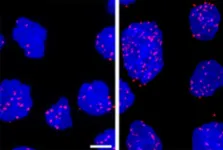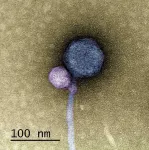(Press-News.org) A surprising mechanism that makes some cancers treatment-resistant has been discovered by Weill Cornell Medicine and NewYork-Presbyterian investigators. The mechanism, which involves the shuttling of messenger RNAs (mRNAs) from the nucleus to the cytoplasm, ultimately facilitates DNA repair in cancer cells. These cancer cells can thereby thwart treatments aimed at damaging their DNA.
In a project encompassing both fundamental research and clinical studies they demonstrated that a combination of approved chemotherapies, one of which targets the DNA repair-facilitating mechanism, could help treat these persistent cases. While the work, published Oct. 6 in Cancer Research, focused on diffuse large B-cell lymphoma (DLBCL), the findings likely apply to other cancer types as well.
DLBCL is the most common form of lymphoma, affecting about 30,000 patients annually in the United States alone. First-line therapies cure about two thirds of patients, “but for people who aren’t cured or who relapse, they historically had poor outcomes with standard chemotherapy-based treatment approaches,” said co-lead author Dr. Sarah Rutherford, an assistant professor of medicine at Weill Cornell Medicine and a hematologist/oncologist at NewYork-Presbyterian/Weill Cornell Medical Center. The other co-lead author is Dr. Rossella Marullo, an instructor in medicine at Weill Cornell Medicine.
Previous research had demonstrated that treatment-resistant DLBCL cells often express high levels of a protein called XPO1. In 2019, the U.S. Food and Drug Administration approved a new drug, selinexor, that was designed to target XPO1 and inhibit its activity. The drug, which hinders the growth of lymphoma cells expressing high levels of the protein, is used to treat these refractory cases. Selinexor has helped many, but not all patients with treatment-resistant disease.
“Selinexor is effective by itself, it’s just not as effective as we’d like it to be,” said Dr. Rutherford, who is also a member of the Sandra and Edward Meyer Cancer Center at Weill Cornell Medicine. That’s driven her to search for ways to improve the drug’s efficacy.
Meanwhile, Dr. Rutherford’s colleagues were trying to learn more about exactly how selinexor works. Its target, XPO1, transports hundreds of proteins, and certain RNAs, out of the cell nucleus, primarily to separate the pool of proteins that should not be present in the nucleus, such as ribosomal proteins.
However, the investigators found that some of these XPO1-exported proteins are also bound to mRNA molecules; thus, these mRNAs are exported out of the cell nucleus into the cytoplasm where they can be translated into proteins. This new mechanism indicates that the quantity and activity of XPO1 in a cell can therefore affect the expression levels of numerous genes.
“We found that it’s not just regulating a few proteins, it’s coordinating these big programs, allowing cells to rapidly adjust their proteome and survive different kinds of stress that cancer cells encounter all the time,” said senior author Dr. Leandro Cerchietti, the Richard Stratton Associate Professor of Hematology and Oncology and a member of the Meyer Cancer Center at Weill Cornell Medicine.
Taking some treatment resistant DLBCL cells from patients and grafting them into preclinical models, the researchers found that higher levels of XPO1 ultimately increases the expression of genes that protect cells against death from DNA damage. Inhibiting XPO1 in those models with selinexor increased the lymphomas’ sensitivity to DNA-damaging chemotherapies and immune-based treatments.
“We were excited, and based on some of Dr. Cerchietti’s research, we thought selinexor would likely synergize with other chemotherapies,” said Dr. Rutherford. To test that in patients, she initiated a phase 1 clinical trial, aiming to determine whether such a combination would be safe, and if so at what doses. The trial, which primarily enrolled patients with treatment-resistant DLBCL, showed that the combined regimen is not only safe, but appears to work. Though the data set is too small to draw definitive conclusions, several patients had better outcomes than expected.
Dr. Rutherford is eager to continue testing and refining the new regimens in follow-up trials. “It has been a really exceptional time over the last four years or so in this disease, where we now have many more therapies than we did when we first started the trial,” she said.
Because every cell in the body expresses XPO1, the new results are likely to have broader applications. “There are other tumors in which XPO1 is overexpressed, so it’s really a nice backbone to build on,” said Dr. Cerchietti.
Many Weill Cornell Medicine physicians and scientists maintain relationships and collaborate with external organizations to foster scientific innovation and provide expert guidance. The institution makes these disclosures public to ensure transparency. For this information, see profile for Dr. Sarah Rutherford.
END
New strategy attacks treatment-resistant lymphomas
2023-11-02
ELSE PRESS RELEASES FROM THIS DATE:
At least 14% of Americans have had long COVID
2023-11-02
One in seven people in the US reported having had long Covid by the end of 2022, suggests a large-scale investigation of long Covid and symptom prevalence by academics at UCL and Dartmouth.
Having had long Covid is associated with anxiety and low mood, as well as an increased likelihood of continued physical mobility problems and challenges with memory, concentration or understanding, according to the findings published in PLOS ONE.
The risk of anxiety and low mood appeared to be lower for those who have been vaccinated, ...
Mount Sinai researchers receive $7 million to improve outcomes for high-risk blood cancer patients from the Multiple Myeloma Research Foundation
2023-11-02
New York, NY (November 2nd, 2023) — The Mount Sinai Health System has received a $7 million grant from the Multiple Myeloma Research Foundation for a three-year project that aims to fast-track novel translational concepts to improve outcomes for people with high risk myeloma, the second most common blood cancer in the United States.
This grant award will facilitate a multidisciplinary research project that will analyze a large, diverse cohort of patient samples from all over the United States at the genomic and immune level and apply novel functional genomics technology to understand the critical events that drive ...
Pascal Lee awarded the 2023 Carl Sagan Prize for Science Popularization
2023-11-02
November 2, 2023, Mountain View, CA -- The SETI Institute is delighted to announce that Dr. Pascal Lee will be honored with the 2023 Carl Sagan Prize for Science Popularization presented by Wonderfest. The prestigious Sagan Prize recognizes and encourages individuals who “have contributed wonderfully to the public understanding and appreciation of science.” Previous recipients from the SETI Institute include SETI Institute co-founder and SETI pioneer Jill Tarter, senior astronomer Seth Shostak and trustee Andrew Fraknoi.
“I am truly delighted and humbled by this award,” says Pascal Lee, “all the more because Carl Sagan was, and remains, ...
UMBC team makes first-ever observation of a virus attaching to another virus
2023-11-02
No one had ever seen one virus latching onto another virus, until anomalous sequencing results sent a UMBC team down a rabbit hole leading to a first-of-its-kind discovery.
It’s known that some viruses, called satellites, depend not only on their host organism to complete their life cycle, but also on another virus, known as a “helper,” explains Ivan Erill, professor of biological sciences. The satellite virus needs the helper either to build its capsid, a protective shell that encloses the virus’s genetic material, or to help it replicate ...
Research connecting gut bacteria and oxytocin provides a new mechanism for microbiome-promoted health benefits
2023-11-02
The gut microbiome, a community of trillions of microbes living in the human intestines, has an increasing reputation for affecting not only gut health but also the health of organs distant from the gut. For most microbes in the intestine, the details of how they can affect other organs remain unclear, but for gut resident bacteria L. reuteri the pieces of the puzzle are beginning to fall into place.
“L. reuteri is one of such bacteria that can affect more than one organ in the body,” said co-corresponding author Dr. Sara Di Rienzi, ...
How “blue” and “green” appeared in a language that didn’t have words for them
2023-11-02
CAMBRIDGE, MA -- The human eye can perceive about 1 million colors, but languages have far fewer words to describe those colors. So-called basic color terms, single color words used frequently by speakers of a given language, are often employed to gauge how languages differ in their handling of color. Languages spoken in industrialized nations such as the United States, for example, tend to have about a dozen basic color terms, while languages spoken by more isolated populations often have fewer.
However, the way that a language ...
Plant populations in Cologne are adapted to their urban environments
2023-11-02
A research team from the Universities of Cologne and Potsdam and the Max Planck Institute for Plant Breeding Research has found that the regional lines of the thale cress (Arabidopsis thaliana), a small ruderal plant which populates the streets of Cologne, vary greatly in typical life cycle characteristics, such as the regulation of flowering and germination. This allows them to adapt their reproduction to local environmental conditions such as temperature and human disturbances. The researchers from Collaborative Research Center / Transregio 341 “Plant Ecological Genetics” found that environmental ...
Making gluten-free, sorghum-based beers easier to brew and enjoy
2023-11-02
Though beer is a popular drink worldwide, it’s usually made from barley, which leaves those with a gluten allergy or intolerance unable to enjoy the frothy beverage. Sorghum, a naturally gluten-free grain, could be an alternative, but complex preparation steps have hampered its widespread adoption by brewers. Now, researchers reporting the molecular basis behind sorghum brewing in ACS’ Journal of Proteome Research have uncovered an enzyme that could improve the future of sorghum-based beers.
Traditionally, beer brewers start with barley grains, which they malt, mash, ...
Jurassic worlds might be easier to spot than modern Earth
2023-11-02
ITHACA, N.Y. –Things may not have ended well for dinosaurs on Earth, but Cornell University astronomers say the “light fingerprint” of the conditions that enabled them to emerge here provide a crucial missing piece in our search for signs of life on planets orbiting alien stars.
Their analysis of the most recent 540 million years of Earth’s evolution, known as the Phanerozoic Eon, finds that telescopes could better detect potential chemical signatures of life in the atmosphere of an Earth-like exoplanet more closely resembling the age the dinosaurs inhabited than the ...
Archaeology: Larger-scale warfare may have occurred in Europe 1,000 years earlier
2023-11-02
A re-analysis of more than 300 sets of 5,000-year-old skeletal remains excavated from a site in Spain suggests that many of the individuals may have been casualties of the earliest period of warfare in Europe, occurring over 1,000 years before the previous earliest known larger-scale conflict in the region. The study, published in Scientific Reports, indicates that both the number of injured individuals and the disproportionately high percentage of males affected suggest that the injuries resulted from a period of conflict, potentially lasting at least months.
Conflict during the European Neolithic period (approximately 9,000 ...




